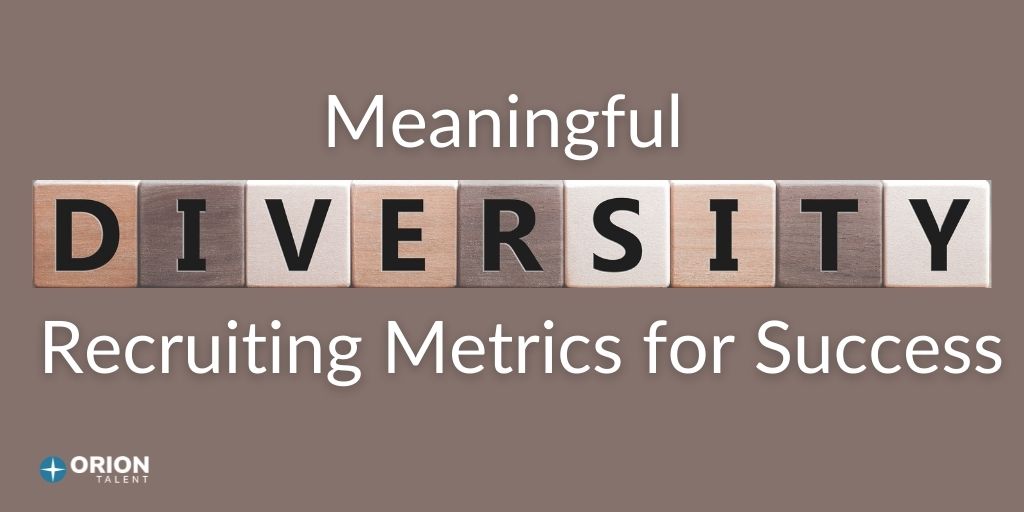
The Most Important Diversity Recruiting Metrics
Talent acquisition professionals know that recruiting metrics are essential to measuring how successful recruiting initiatives are. After all, you can’t improve (or even benchmark) what you don't measure. This is particularly true for Diversity, Equality, and Inclusion programs. These metrics can give you a granular look at the culture you are creating. Hopefully, when taken as a whole, your diversity metrics will reflect an inclusive culture. Companies that authentically value diversity attract top talent seeking purpose-driven work in a very tight talent market.
For Heather Joines, Head of Talent Acquisition at Altice USA, these metrics provide an important window into an organization's progress toward their diversity goals. She explains, "It is imperative to continuously evaluate diversity metrics from various perspectives; as true change comes over time and with dedication to program implementation. To fully understand the fluid nature of talent within the organization, these metrics should include hiring, attrition, promotions, and internal mobility at a minimum.”
“Inclusion is extremely important to our organization, and it is integral when moving at such a fast pace to stop and evaluate progress and be thoughtful about the evolution of our goals and initiatives," Heather adds.
Defining Diversity Metrics
When defining diversity metrics for your organization, it is important to select metrics that will clearly illustrate progress (or lack thereof) toward your overall diversity goals. To create a well-thought-out DEI initiative, you should identify risk areas, set goals, assign responsibility, and decide which metrics to use. Doing so can have many benefits including:
- fostering employee trust and satisfaction,
- strengthening employer brand,
- engaging stakeholders,
- strengthening leadership commitment,
- securing additional resources, and
- advocating for further change.
Diversity metrics should focus on three key areas and compare employees to the available talent pool when applicable. First, diversity performance measures should be used for diagnosis purposes. By looking at representation, recruitment, promotion, and pay, you can detect what areas need the most work.
Second, they can be used to track progress. Once you know the selection rate for people of color, for example, in interviews, you can track that metric to see the progress you are making through your initiative. Perhaps you are tackling the gender pay gap. A downward trend in that metric is a sign you are on the right track.
Finally, these metrics can help determine ROI on your diversity initiatives. The hard data and bottom line matters, and seeing improvements in profits and productivity in relation to positive increases in DEI metrics can only improve buy-in at all levels.
For all of these metric types, it is important to compare your own employees to the available applicant pool, as well as across organizational levels. Is the percentage of candidates of diverse backgrounds less than that of the overall percentage represented in the applications you received? Are diverse employees being represented in leadership? These are simple metrics to calculate that make a big impact on employees.
According to Tyler DeBoard, Global Director, Talent Partnerships, at WPP, a marketing services company, “As a gay man, it’s always been important for me to see executives with a shared experience to my own. If I can’t see people like myself leading our company, I won’t see the potential for me to become a leader myself. We will continue to improve with a focus not only on recruitment, but on creating ecosystems of support for all employees to grow and develop with us.”
Employee Satisfaction with DEI Initiatives
Like Tyler explained above, beyond the raw data, the employee experience is important. Luckily, this is still measurable through employee surveys. A simple five-question Employee Satisfaction survey covering their feelings on how your company is handling diversity, equity, and inclusion can provide quantifiable data that can be tracked.
Exploring Turnover
Costs, morale, and employer brand are all affected by turnover. The same can be said when a company is experiencing higher than normal turnover from diverse employees. This is a red flag and a time to investigate, making this an essential metric. Important questions to ask, perhaps in an exit interview, include:
- Who is leaving?
- Why are they leaving?
- What departments are they leaving?
- What managers are they leaving?
- What positions are they leaving?
“Many organizations are looking at their internal representation data – identifying the gaps and finding ways to bring in new voices and perspectives. One important piece of data that’s often overlooked is retention data, especially for groups that have been historically excluded from our industries,” explains Tyler, “It’s critical that we look closely at who is leaving and why, because underrepresented groups face issues in the workforce that others simply do not. At WPP, we’re creating more career development programs, establishing stronger mentorship for rising talent, and building stronger pathways into the C-suite.”
Meaningful Metrics Put Into Action
For any of the types of metrics we have discussed to work, they have to mean something. Set a baseline, establish your goals, track your progress, report regularly on that progress, and review what is working and what isn’t. Only by taking action on the data can you use these metrics to take important steps forward in your DEI initiatives. And, if your diversity metrics are looking good, you are ahead of the curve. But your work should not end there. Figure out what it is that is working, continue to leverage it, and then share it with others!
If you are interested in accessing talented candidates with diverse backgrounds, including minorities, women, people with disabilities, individuals from the LGBTQIA+ community, and members of other underrepresented groups, to reach your diversity outreach goals, please visit Hirepurpose Diversity Sourcing and Talent Attraction.
Sign up for More Diversity Insights
Archives
- April 2025
- March 2025
- February 2025
- October 2024
- May 2024
- March 2024
- February 2024
- January 2024
- December 2023
- November 2023
- October 2023
- September 2023
- August 2023
- July 2023
- June 2023
- May 2023
- April 2023
- March 2023
- February 2023
- January 2023
- December 2022
- November 2022
- October 2022
- September 2022
- August 2022
- July 2022
- June 2022
- May 2022
- April 2022
- March 2022
- February 2022
- January 2022
- December 2021
- November 2021
- October 2021
- September 2021
- August 2021
- July 2021
- June 2021
- May 2021
- April 2021
- March 2021
- February 2021
- January 2021
- December 2020
- November 2020
- October 2020
- September 2020
- August 2020
- July 2020
- June 2020
- May 2020
- April 2020
- March 2020
- February 2020
- January 2020
- December 2019
- November 2019
- October 2019
- September 2019
- August 2019
- July 2019
- June 2019
- May 2019
- April 2019
- March 2019
- February 2019
- January 2019
- December 2018
- November 2018
- October 2018
- September 2018
- August 2018
- July 2018
- June 2018
- May 2018
- April 2018
- March 2018
- February 2018
- January 2018
- December 2017
- November 2017
- October 2017
- September 2017
- August 2017
- July 2017
- June 2017
- May 2017
- March 2017
- February 2017
- January 2017
 RSS Feed
RSS Feed
Subscribe to Orion's Blog
Featured Blogs





.jpg)















